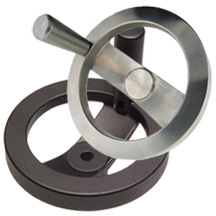
When shopping for handwheels, you may notice that some of them feature a bore. Handwheels are commonly used in adjustment applications that require a turning force. You can connect them to a machine or equipment, after which you can use the handwheels to make adjustments via turning. Before buying a handwheel, though, you should check to see whether it features a bore.
The Definition of a Handwheel Bore
A handwheel bore is a precut, drilled or “bored” hole in the center of a handwheel. All handwheels consist of a circular, wheel-shaped mechanism. Some of them have a handle as well, which protrudes vertically out of the rim. In the center of a handwheel, you may discover a hole. This hole is a bore.
Some handwheels have a wider bore than others. Bore sizes are measured by diameter. A large diameter indicates a wide bore. A small diameter indicates a smaller and narrower bore. Regardless of the size, if a handwheel features a hole in the center, it’s a bored handwheel.
The Importance of a Bore
Handwheels feature a bore for installation purposes. To install a handwheel, you’ll need to mount it to the machine or equipment that you want to adjust. As long as the machine or equipment has a shaft, you can install the handwheel by sliding it onto this shaft.
The presence of a bore will allow you to install the handwheel on the shaft. Bores are holes, whereas shafts are rods or stems. Assuming the shaft and bore are of equal sizes, you can connect them. After sliding the handwheel onto the shaft, you can turn the handwheel to make adjustments.
If a handwheel doesn’t have a bore, you may be able to create one yourself by cutting a hole in the center. The problem with creating your own bore, though, is that it may not hold the handwheel in place.
Understanding the Different Types of Bores
Not all bores consist of smooth, clean holes. Since they are used to make adjustments, handwheels must be designed so that they won’t off the machine or equipment with which they are used. Fortunately, there are many different types of bores that can hold handwheels in place.
Some handwheels feature a hexagonal bore with a set screw. Other handwheels feature a tapered shaft with a locking bolt or a half-square shaft with a set screw. With these alternative bore types, the handwheel will remain locked in place once installed.
